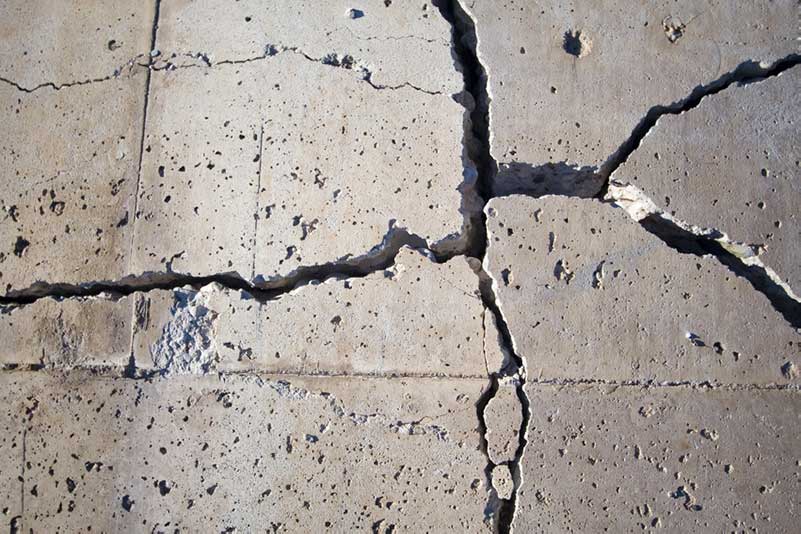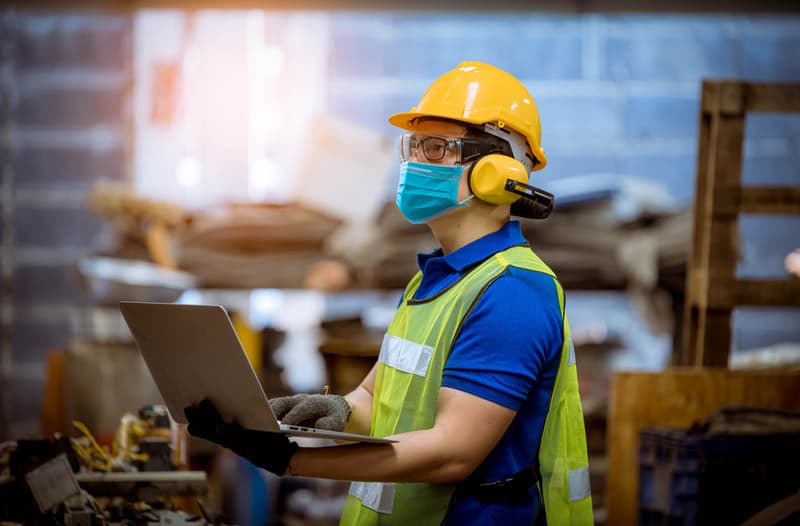- Bendable ‘concrete’ solves cracking problems
- Will electrified concrete spell the end of frozen roads?
- Self-healing concrete trials underway
- Solar roads pilots in the US and France
- CAT construction equipment company introduces phone with thermal imaging
- Cab-less autonomous dump truck eliminates impractical 3-point-turns
- Surface-clinging drones to identify and inspect structural damage
Construction and technology didn’t always mix as nicely as they do today. In recent years, however, tech companies and the construction industry have found each other and we’ve subsequently seen some incredible advances. We’re talking inspection drones, solar technology in roads and robotic working gloves, for instance. In this article we look at some of the latest tech developments revolutionising the construction industry.
Free trendservice
1. Bendable ‘concrete’ solves cracking problems
Concrete is the most widely used building material in the world. The problem is that it is not flexible and therefore prone to cracking. Now, a group of scientists from the Nanyung Technological University in Singapore have developed a product called ConFlexPave that is thinner and stronger than traditional concrete and even bends under pressure. Instead of cement, aggregate and water, ConFlexPave is made from a mixture of hard materials and polymer microfibres. It looks like concrete, even though it really isn’t. The material is fifty times more flexible and forty times lighter than traditional concrete, making it the perfect choice for use in the construction of, for instance, skyscrapers. This bendable concrete can be used for the quick and efficient installation of precast pavement slabs, reducing the time required for road works and new pavements by more than fifty percent. The material is also more sustainable, which means it requires less maintenance. The superior energy absorbing properties of this bendable concrete also make it perfectly suitable for use in seismic zones.

2. Will electrified concrete spell the end of frozen roads?
For years, scientists have been trying to find clever solutions for clearing roads of ice, and Professor Chris Tuan from the University of Nebraska at Lincoln is now very close to a breakthrough. He has developed a special, electrified concrete that can lead to snow and ice free road surfaces. The mixture is made up of 80 percent standard concrete and 20 percent carbon particles and metal fibre that heat up via steel rods in the concrete. This generates enough heat for the surface to melt snow- and ice buildup, even in the heaviest winter storms. The electrified concrete is currently being tested by the Federal Aviation Administration. If successful, the concrete will initially be used on airport tarmacs but of course the innovative concept would also make snow clearing on city roads much more effective.
3. Self-healing concrete trials underway
A team of researchers at Cardiff University is conducting a trial with three types of self-healing concrete at a site in the South Wales Valleys. The objective is to eventually incorporate these self-healing techniques into one single system that could be used to self-repair concrete structures in the built environment. The system should automatically sense when change happens in its structure and then autonomously repair itself, without any human intervention, as soon as damage occurs. One technique will pump inorganic and organic healing agents through a network of thin ‘veins’ in the concrete to fix damage. The second technique makes use of shape-shifting or shape-memory polymers that can transform into a different, memorised shape when heated. This technique would be especially suitable to repair or minimise cracks. The third technique involves embedding lightweight aggregates or minuscule capsules containing healing agents and bacteria into the concrete. These tiny capsules release their contents when a crack forms and the bacteria will then produce calcium carbonate, filling the crack in the concrete. Structures made with these intelligent self-healing materials will be safer, more durable and more cost effective than traditional concrete structures.
https://www.youtube.com/watch?v=laqACVY1U_k
4. Solar roads pilots in the US and France
The solar roads made by tech startup Solar Roadways in Idaho are made up of ultra-strong, 30 kg hexagonal glass panels with solar energy storage capabilities. The panels are so strong, they can withstand the weight of a small truck. Not only do they generate heat in order to melt ice and snow, they can also be programmed to generate many of different colours, eliminating the need for expensive road marking and possibly even traffic signalling systems. The US Department of Transportation has given the startup various grants to test the feasibility of their solar roadways and perfect the concept. Panels are currently being tested in the form of a sidewalk at the Route 66 Welcome Centre in Conway, Missouri, along the famous Route 66.
Meanwhile, in the village of Tourouvre au Perche in Normandy, the world’s first kilometre-long solar highway was recently opened. The road contains 2,800 m2 of photovoltaic cells and the aim of the project is to power the streetlights and approximately 140 homes in the village. The solar road technology is called WattWay and is developed by Anglo-French construction company Colas. The road will be tested for two years to see if it will generate enough energy and to determine whether it will be able to withstand the heavy traffic volumes. The panels are very thin and have been installed on top of the existing road, making them far more cost effective than other solar road panels, whose installation is generally cripplingly expensive. France’s ecology minister wants to eventually replace one of every 1,000 kilometres roadway in France with solar roadways.
5. CAT construction equipment company introduces phone with thermal imaging
The well-known heavy construction equipment company CAT has now introduced a rugged and awesome piece of technology – the CAT S60 smartphone. It has the ability to withstand drops of almost two metres and can stay underwater at depths of more than five metres for longer than an hour, making it perfect for the construction industry. The phone has a thermal imaging camera and can even see through smoke! This revolutionary piece of technology offers the user the ability to see changes in temperature up to 30 metres away and can read specific temperatures between 15-23 metres. Actually the CAT S60 takes two photos simultaneously. The first one with the thermal camera and the second one with the standard lens after which the images are placed on top of each other. This provides a more detailed image that allows the user to pinpoint the exact locations of the heat signatures. Not only does the smartphone shoot stills, it can also take footage and timelapse videos. The user can apply spectrum filters and movable spot metres to live images as well as thermal images. The integrated thermal imaging smartphone can detect and resolve problems with machinery or a structure before they become problematic. The device enables the user to trace electrical faults or overloaded sockets, fix underfloor heating problems and identify insulation leaks. The possibilities with the CAT S60 are virtually endless.
6. Cab-less autonomous dump truck eliminates impractical 3-point-turns
Long before we started seeing Tesla’s and Google’s self-driving cars on the roads, Japanese equipment manufacturer Komatsu has been making self-driving vehicles for the mining industry from as early as 2008. Since then, more than 1 billion tons of cumulative materials have been hauled by their vehicles. Now they have developed an autonomous haul truck without a cab for an operator or human driver. The 458 ton autonomous and cab-less dump truck has no front- or back ends, enabling the vehicle to change direction without having to perform 3-point-turns. This is a huge productivity booster and time saver, especially in confined spaces and areas with uneven or slippery surface conditions. The fact that the truck has no cab also results in remarkable balance as the weight of the load can be distributed much more evenly.
7. Robotic gloves designed for space now available on Earth
The RoboGlove was initially designed to enable astronauts to perform mechanical repairs on the International Space Station more efficiently and more quickly without suffering from muscle fatigue when back on Earth. The technology was originally developed by NASA and GM in 2012 but has now been licenced to Swedish medical tech company Bioservo Technologies. The RoboGlove makes use of artificial tendons and actuators to mimic human hand muscles. The pressure sensors in the gloves detect when the user holds an object, triggering an artificial tendon to strengthen the grip. This soft exoskeleton is lightweight and can greatly enhance the strength of the wearer. Other companies like Panasonic, BMW and Hyundai are also working on the development of exoskeletons to help workers in construction and manufacturing.
8. Surface-clinging drones to identify and inspect structural damage
Japanese company PRODRONE recently developed the flying and ‘clinging’ PD6-CI-L inspection drone to make the inspection of bridges and buildings more effective. Because most drones available today are not able to hover close to a structure while simultaneously handling gusts of wind, the Japanese manufacturer designed their drone to operate using negative pressure. This means that the drone basically ‘clings’ to the structure it’s inspecting. The drone is shaped in the form of an upside-down ‘L’, enabling it to cling to horizontal as well as vertical structures, making it especially suitable for bridge inspections. Because the PD6-CI-L is able to maintain a constant distance from the inspection area, the drone is capable of identifying cracks as thin as 0.1 mm.








